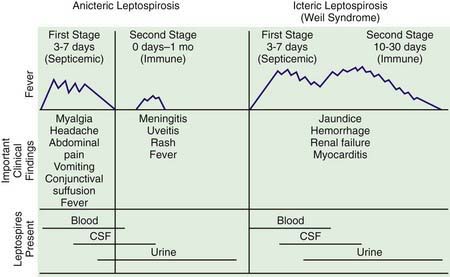Chapter 212 Leptospira
Leptospirosis is a common and widespread zoonosis in the world and is caused by spirochetes of the genus Leptospira.
Etiology
Leptospira are aerobic spiral bacteria with a terminal hook at 1 or both ends. Pathogenic leptospires belong to a single species, Leptospira interrogans, which includes >200 distinct serovars. A single serovar can produce a variety of distinct syndromes, and a single clinical manifestation may be caused by multiple serotypes. Nonpathogenic leptospires are classified as Leptospira biflexa, with >60 serovars.
Epidemiology
Most human cases of leptospirosis occur in tropical and subtropical countries, but the distribution is worldwide. The rat is the principal source of human infection, but leptospires infect many species of domestic and feral animals, including livestock, birds, fish, dogs, cats, and wild animals, including reptiles. Infected animals excrete spirochetes in their urine for prolonged periods. Most human cases result from occupational exposure to water or soil contaminated with rat urine. Groups with a high incidence of leptospirosis include persons exposed occupationally or recreationally to contaminated soil or water, agricultural workers, veterinarians, abattoir workers, meat inspectors, rodent control workers, laboratory workers, and workers in other occupations that require contact with animals. The major animal reservoir in the USA is the dog. Transmission via animal bites and directly from person to person has been rarely reported.
Pathology and Pathogenesis
Leptospires enter humans through abrasions and cuts in the skin or through mucous membranes. After penetration, they circulate in the bloodstream to all body organs, causing endothelial lining damage of small blood vessels with secondary ischemic damage to the end organs.
Clinical Manifestations
The spectrum of human leptospirosis ranges from asymptomatic infection (most cases) to severe disease with multiorgan dysfunction and death. The onset is usually abrupt, and the illness tends to follow a biphasic course (Fig. 212-1). After an incubation period of 7-12 days, there is an initial or septicemic phase lasting 2-7 days, during which leptospires can be isolated from the blood, cerebrospinal fluid (CSF), and other tissues. This phase may be followed by a brief period of well-being before onset of a second symptomatic immune or leptospiruric phase. This phase is associated with the appearance of circulating antibody, disappearance of organisms from the blood and CSF, and appearance of signs and symptoms associated with localization of leptospires in the tissues. Despite the presence of circulating antibody, leptospires can persist in the kidney, urine, and aqueous humor. The immune phase can last for several weeks. Symptomatic infection may be anicteric or icteric.

Figure 212-1 Stages of anicteric and icteric leptospirosis. Correlation between clinical findings and presence of leptospires in body fluids, CSF, cerebrospinal fluid.
(Reprinted with permission from Feigin RD, Anderson DC: Human leptospirosis, CRC Crit Rev Clin Lab Sci 5:413–467, 1975. Copyright CRC Press, Inc, Boca Raton, FL.)

Full access? Get Clinical Tree


